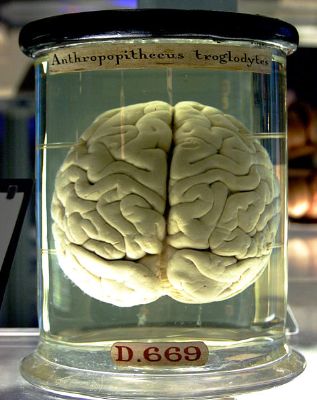
A Chimp Brain Under Glass, London Science Museum (Wikipedia)
All my work at ASH was on the graveyard shift (11 PM-7 AM). Only one or two staff were on duty on the floors where I worked, yet with 30-40 patients under our care. Every now and then one of the patients would expire, more so on these floors than in general, because most of the folks in our beds had both severe mental and medical difficulties. When a death occurred, a nurse supervisor would be notified, she would let the on-call physician know, and we would be instructed to put the body on a gurney, use the large elevator, and then wheel the corpse down to the basement morgue.
 A Chimp Brain Under Glass, London Science Museum (Wikipedia) |
I do not recall that the Austin Police Department was made aware of the situation if a patient died, at least not till after the body were already in our morgue area. In retrospect, that seems an oversight, for who is to say if the causes of death were in all cases natural? Besides other considerations, like the state workers, not all of whom at all times were law-abiding, at least one of our residents was there on a commitment for the criminally insane and rumored to have offed a couple people. He was not kept in isolation but had free movement on one of our floors and in fact did some of the janitorial duties. While I was there, he used his broom handle to pop another resident hard enough to raise an egg-sized lump on the forehead.
I possibly have remembered it wrong, and the containers were really in a separate room, but my recollection is that the most interesting thing about the morgue, other than, of course, that at any given time there might be one or two dead people and it was kept cold down there, was the collection of human brains, one each, floating in a clear preservative liquid in big glass jars that were labeled and arrayed for easy viewing, presumably by physicians, medical students, and neuroscience biologists.
These brains varied in the ages of their former owners. As best I remember, there were "specimens" from young children who had evidently died of severe hydrocephalus, others from end-stage syphilis victims, ones from people who must have had advanced diabetes, some from people with Down's Syndrome, one from someone who had been shot in the head, others whose labels indicated they were alcoholics and whose brains, even to my layman's eyes, looked badly affected by the disease. I wondered how well they had continued to function in their ordinary lives, given the evident loss not merely of synaptic connections but even of significant amounts of gray matter. Thinking of an aunt of mine who against her will was given a hysterectomy when an inpatient in CA, I asked myself too if the individuals whose brains were neatly labeled and exposed before me had given their permission to have these main organs of identity on display for years after their bodies had otherwise been disposed of.
Decades later, I heard during an NPR's "Morning Edition" program a report about these and other brains that had been collected by departments of the State of TX, including one that had been added awhile after my employment there, that of the famous University of TX at Austin sniper, Charles Whitman, who from the UT Tower in 1966 shot and killed numerous people, one of my sister's teachers among the multiple victims.
According to the report, scores of the brains, Charles Whitman's possibly among them, were missing and had not been accounted for in many years. Whitman at least had wanted his brain preserved and studied, leaving a suicide note partly to that effect, hoping the researches might reveal the cause for his dysfunction. They did indeed show that he had a brain tumor, though it cannot be known if this was directly related to his shooting spree.
I pondered how the missing brains might be sitting on a shelf in someone's home. Now there would be a hobby for the record books. Few can say they collect not stamps or coins but human brains.